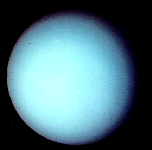Uranus
 The third largest planet, Uranus was discovered in 1781 by William
Herschel. It was visited in 1986 by the Voyager 2 spacecraft which discovered
much about this strange world.
The third largest planet, Uranus was discovered in 1781 by William
Herschel. It was visited in 1986 by the Voyager 2 spacecraft which discovered
much about this strange world.
Uranus is notable because, unlike the other giant planets, it lies on its side with its pole towards the Sun and its ring system vertical. It rotates in the opposite direction to the other planets as well, and its magnetic field is also offset by 60 degrees from the normal polar location. Despite the fact that only its poles receive direct sunshine, Uranus’ equator is still its hottest place, though no one knows why this is so. Unlike Jupiter and Saturn, Uranus has no strata in its atmosphere and no core. All of Uranus is made of the same gas and ices (mostly hydrogen and helium with enough methane to give the planet its blue colour) so what you see outside is what you get inside.�
|
Diameter |
51, 118 km |
|
Mass |
8.69 × 1025kg |
|
Mean Distance from sun |
2,870,990,000 km |
|
Mean Density |
1.29 g/cm3 |
|
Rotational Period * |
-0.66 Earth days |
|
Orbital Period |
84 Earth years |
|
Mean Orbital Velocity |
6.8 km/s |
|
Atmosphere |
83% hydrogen, 15% helium, 2% methane |
|
Average Surface Temperature |
-193°C |
|
Equatorial Surface Gravity |
8.7 m/s2 |
* A negative rotational period indicates that the planet is rotating in the opposite direction than the other planets.
| Copyright owned by the State of Victoria (Department of Education and Early Childhood Development). Used with Permission. |
|
|||||||||||||||||||||||||||||||||||||||||||||||||||||||||||||||||||||||||||||||||||||